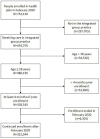This is a preprint.
Renin-angiotensin-aldosterone system inhibitors and COVID-19 infection or hospitalization: a cohort study
- PMID: 32676610
- PMCID: PMC7359535
- DOI: 10.1101/2020.07.06.20120386
Renin-angiotensin-aldosterone system inhibitors and COVID-19 infection or hospitalization: a cohort study
Update in
-
Renin-Angiotensin-Aldosterone System Inhibitors and COVID-19 Infection or Hospitalization: A Cohort Study.Am J Hypertens. 2021 Apr 20;34(4):339-347. doi: 10.1093/ajh/hpaa168. Am J Hypertens. 2021. PMID: 33048112 Free PMC article.
Abstract
There are plausible mechanisms by which angiotensin-converting enzyme inhibitors (ACEIs) and angiotensin receptor blockers (ARBs) may increase the risk of COVID-19 infection or affect disease severity. To examine the association between these medications and COVID-19 infection or hospitalization, we conducted a retrospective cohort study within a US integrated healthcare system. Among people aged ≥18 years enrolled in the health plan for at least 4 months as of 2/29/2020, current ACEI and ARB use was identified from pharmacy data, and the estimated daily dose was calculated and standardized across medications. COVID-19 infections were identified through 6/14/2020 from laboratory and hospitalization data. We used logistic regression to estimate adjusted odds ratios (ORs) and 95% confidence intervals. Among 322,044 individuals, 720 developed COVID-19 infection. Among people using ACEI/ARBs, 183/56,105 developed COVID-19 (3.3 per 1000 individuals) compared with 537/265,939 without ACEI/ARB use (2.0 per 1000), yielding an adjusted OR of 0.94 (95% CI 0.75-1.16). For use of < 1 defined daily dose vs. nonuse, the adjusted OR for infection was 0.89 (95% CI 0.62-1.26); for 1 to < 2 defined daily doses, 0.97 (95% CI 0.71-1.31); and for ≥2 defined daily doses, 0.94 (95% CI 0.72-1.23). The OR was similar for ACEIs and ARBs and in subgroups by age and sex. 29% of people with COVID-19 infection were hospitalized; the adjusted OR for hospitalization in relation to ACEI/ARB use was 0.92 (95% CI 0.54-1.57), and there was no association with dose. These findings support current recommendations that individuals on these medications continue their use.
Figures



References
-
- Zhou P, Yang XL, Wang XG, Hu B, Zhang L, Zhang W, Si HR, Zhu Y, Li B, Huang CL, Chen HD, Chen J, Luo Y, Guo H, Jiang RD, Liu MQ, Chen Y, Shen XR, Wang X, Zheng XS, Zhao K, Chen QJ, Deng F, Liu LL, Yan B, Zhan FX, Wang YY, Xiao GF, Shi ZL. A pneumonia outbreak associated with a new coronavirus of probable bat origin. Nature. 2020;579(7798):270–273. - PMC - PubMed
-
- Kuba K, Imai Y, Rao S, Gao H, Guo F, Guan B, Huan Y, Yang P, Zhang Y, Deng W, Bao L, Zhang B, Liu G, Wang Z, Chappell M, Liu Y, Zheng D, Leibbrandt A, Wada T, Slutsky AS, Liu D, Qin C, Jiang C, Penninger JM. A crucial role of angiotensin converting enzyme 2 (ACE2) in SARS coronavirus-induced lung injury. Nature medicine. 2005;11(8):875–879. - PMC - PubMed
Publication types
Grants and funding
LinkOut - more resources
Full Text Sources
